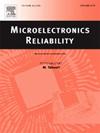Effect of filer content on the thermal characteristics of underfill materials for Ball-Grid-Array component package
IF 1.6
4区 工程技术
Q3 ENGINEERING, ELECTRICAL & ELECTRONIC
引用次数: 0
Abstract
High-density integration and fast processing speed in the semiconductor industry have increased heat generation in electronic devices. Underfill materials, known for their high thermal conductivity and low coefficient of thermal expansion (CTE), offer a potential solution to dissipate heat and improve device reliability. In this study, we investigate the effect of filler content on the thermal reliability of underfill materials for ball grid array (BGA) component packaging. Mainly, we investigate the thermal conductivity, CTE, and mechanical properties of different filler contents of Al2O3 and Al2O3–BN hybrid underfills to facilitate heat dissipation and improve device reliability. The thermal conductivity of the underfill materials was evaluated by measuring the surface temperatures of underfill molded flip-chip light-emitting diodes (FCLEDs). The mechanical properties and thermo-mechanical reliability of the underfill materials were evaluated via a three-point bending test of the underfill packaged BGA components after the thermal shock test. The results showed that optimizing underfill properties based on specific application environments is crucial for obtaining enhanced thermal reliability and mechanical properties of underfill packaged BGA components.
滤料含量对球栅阵列元件封装底部填充材料热特性的影响
半导体行业的高密度集成和快速处理速度增加了电子设备的发热量。底部填充材料以其高热导率和低热膨胀系数(CTE)而著称,为散热和提高器件可靠性提供了一种潜在的解决方案。在本研究中,我们研究了填充物含量对球栅阵列(BGA)元件封装用底部填充材料热可靠性的影响。主要研究了不同填料含量的 Al2O3 和 Al2O3-BN 混合底部填充材料的热导率、热膨胀系数和机械性能,以促进散热并提高器件可靠性。通过测量底部填充模塑倒装芯片发光二极管(FCLED)的表面温度,评估了底部填充材料的导热性。通过对热冲击测试后的底部填充封装 BGA 元件进行三点弯曲测试,评估了底部填充材料的机械性能和热机械可靠性。结果表明,根据特定的应用环境优化底部填充材料的性能对于提高底部填充封装 BGA 元件的热可靠性和机械性能至关重要。
本文章由计算机程序翻译,如有差异,请以英文原文为准。
求助全文
约1分钟内获得全文
求助全文
来源期刊

Microelectronics Reliability
工程技术-工程:电子与电气
CiteScore
3.30
自引率
12.50%
发文量
342
审稿时长
68 days
期刊介绍:
Microelectronics Reliability, is dedicated to disseminating the latest research results and related information on the reliability of microelectronic devices, circuits and systems, from materials, process and manufacturing, to design, testing and operation. The coverage of the journal includes the following topics: measurement, understanding and analysis; evaluation and prediction; modelling and simulation; methodologies and mitigation. Papers which combine reliability with other important areas of microelectronics engineering, such as design, fabrication, integration, testing, and field operation will also be welcome, and practical papers reporting case studies in the field and specific application domains are particularly encouraged.
Most accepted papers will be published as Research Papers, describing significant advances and completed work. Papers reviewing important developing topics of general interest may be accepted for publication as Review Papers. Urgent communications of a more preliminary nature and short reports on completed practical work of current interest may be considered for publication as Research Notes. All contributions are subject to peer review by leading experts in the field.
 求助内容:
求助内容: 应助结果提醒方式:
应助结果提醒方式:


